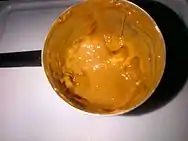Dulce de leche
Dulce de leche (Spanish: [ˈdulse ðe ˈletʃe]; Portuguese: doce de leite), also known as caramelized milk or milk jam in English, is a confection from Latin America prepared by slowly heating sugar and milk over a period of several hours. The resulting substance, which takes on a spreadable, sauce-like consistency, derives its rich flavour and colour from non-enzymatic browning.[2][3] It is typically used to top or fill other sweet foods.
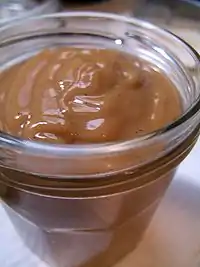 A jar of dulce de leche | |
| Alternative names | Arequipe, doce de leite (Brazil), cajeta, manjar, confiture de lait (France), manjar blanco, kajmak (Poland)[1] |
|---|---|
| Type | Confectionery |
| Region or state | Latin America, France, Morocco, Philippines, Poland[1] |
| Main ingredients | Milk, sugar |
Dulce de leche is Spanish for "sweet [made] of milk". Other regional names in Spanish include manjar ("delicacy") and arequipe; in Mexico and some Central American countries dulce de leche made with goat's milk is called 'cajeta'.[lower-alpha 1][4] In French it is called confiture de lait. It is also known under the name of kajmak in Polish cuisine, where it was independently created based on Turkish kaymak, a kind of clotted cream. Kajmak is most commonly used for wafers or the mazurek pie traditionally eaten on Easter.[1]
Preparation and uses
The most basic recipe calls for slowly simmering milk and sugar, stirring almost constantly until the sugar dissolves (baking soda then can be added), after more constant stirring (between 1.5 - 2 hours) until the mixture thickens and finally turns a rich brown golden-brown colour.[5]
Another method calls for letting a gallon of milk stand in room temperature for an entire 24 hours. The gases will spoil the milk and what is left is curd and whey. This is then boiled, causing the solids to flow to the top. The solids are removed and sugar is added. This mixture is stirred until it becomes hard, after which it is removed from the heat and left to cool. After it cools, it is broken up for consumption. Out of a gallon, this method yields about two cups.
Other ingredients such as vanilla may be added for flavor. Much of the water in the milk evaporates and the mix thickens; the resulting dulce de leche is usually about a sixth of the volume of the milk used. The transformation that occurs in preparation is caused by a combination of two common non-enzymatic browning reactions called caramelization and the Maillard reaction.[2][3]
A homemade form of dulce de leche sometimes is made by boiling an unopened can of sweetened condensed milk for two to three hours (or 30 to 45 minutes in a pressure cooker), particularly by those living in countries where it cannot be bought ready-made. This results in a product that is much sweeter than the slow-boiled kind. This method could be dangerous, and should not be done on a stove: if the pot is allowed to boil dry, the can will overheat and explode.[6]
Dulce de leche can be eaten alone, but is more commonly used as a topping or filling for other sweet foods, such as cakes, churros, cookies (see alfajor), waffles, crème caramel (known as flan in Spanish-speaking regions and pudim in Portuguese-speaking ones), fruits like banana, and ice creams; it is also a popular spread on crepes (panqueques) and toast, while the French variant confiture de lait is commonly served with fromage blanc.
See also
- Baked milk – Beverage derived from milk
- Banoffee pie – English dessert pie
- Basundi – Indian sweet
- Brunost – Norwegian cheese
- Caramel – Confectionery product made by heating sugars
- Caramel candy – Confectionery product made by heating sugars
- Flan – Custard dessert with soft caramel on top
- Condensed Milk
- Custard – Semi-solid cooked mixture of milk and egg
- Krówki – Polish confectionery
- Manjar blanco – Term used in Spanish-speaking area of the world in reference to milk-based delicacies
- Penuche – Candy
- Russian candy
- Ryazhenka
- Sandesh – Bengali confectionery
- Teja – Confectionery
- Tres leches cake – Dessert
Gallery
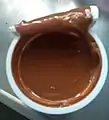 Dulce de leche pot
Dulce de leche pot

 Banoffee pie
Banoffee pie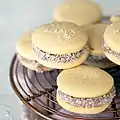
 Dulce de leche-flavored ice cream
Dulce de leche-flavored ice cream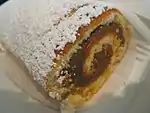 Dulce de leche roll
Dulce de leche roll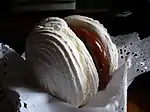 Meringue with dulce de leche
Meringue with dulce de leche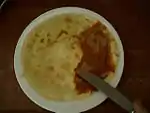
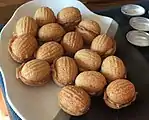 Oreshki
Oreshki
Footnotes
References
- "Polish Chocolate and Dulce de Leche Mazurek". Polish Your Kitchen. 9 April 2017. Retrieved 27 February 2021.
- McSweeney, Paul L. H.; Fox, Patrick F. (20 April 2009). Advanced Dairy Chemistry: Volume 3: Lactose, Water, Salts and Minor Constituents. Springer Science & Business Media. ISBN 978-0-387-84865-5.
- McGee, Harold (2004). On Food and Cooking: The Science and Lore of the Kitchen. New York: Scribner. p. 657. ISBN 0-684-80001-2. Retrieved 8 August 2012.
- "Origen mítico del dulce de leche" [The Mythical Origin of Dulce de Leche] (in Spanish). Clarín. 6 April 2003. Retrieved 8 June 2014.
- "Dulce de Leche". Food Network UK | TV Channel | Easy Recipes, TV Shows. Retrieved 28 October 2022.
- Kijac, Maria Baez (2003). The South American Table: The Flavor and Soul of Authentic Home Cooking from Patagonia to Rio de Janeiro, with 450 Recipes. Boston, MA: Harvard Common Press. p. 391. ISBN 1-55832-249-3. Retrieved 8 August 2012.

